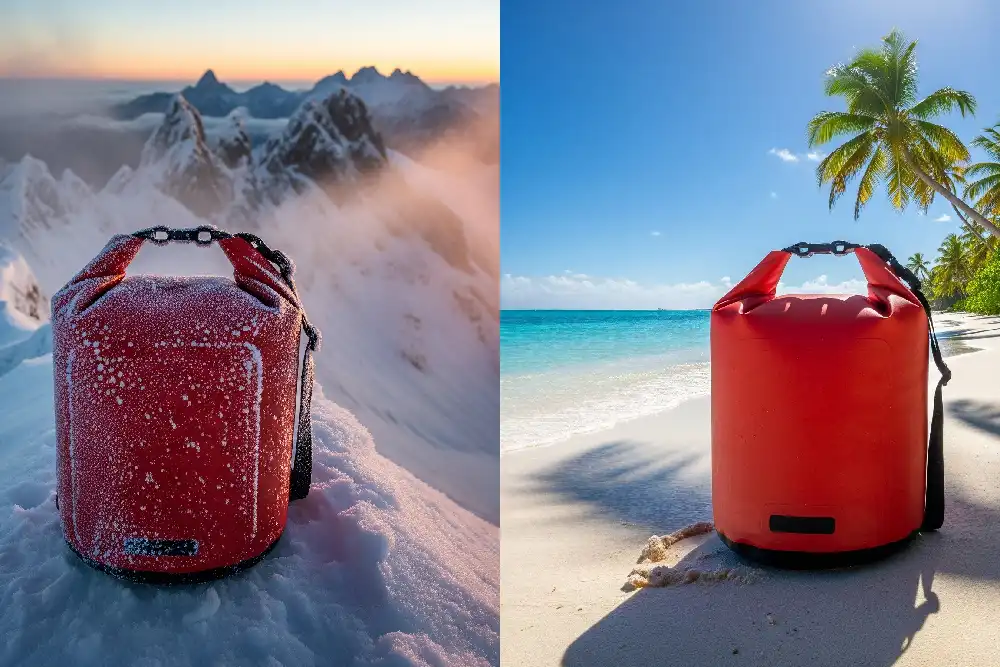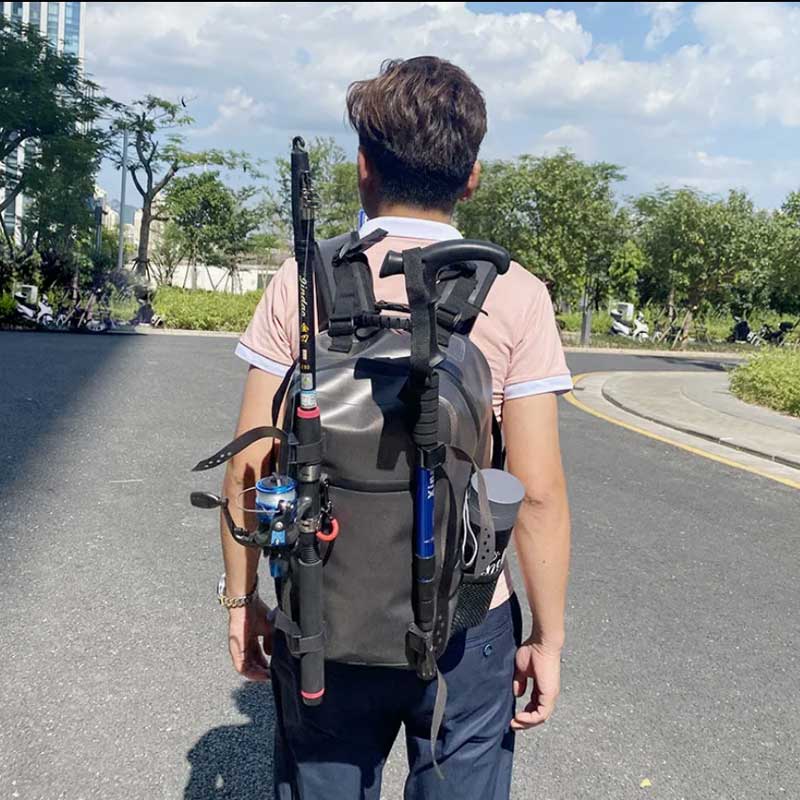What to Know About Waterproof Bags and Temperature Changes

Imagine you are hiking in the summer heat or camping during a cold winter night. Temperature changes can affect how well your waterproof bag protects your gear. Sunlight, heat, and cold can change the way the bag works and how long it lasts. Think about where you store your bag and how you use it. These choices can help you keep your equipment safe.
Key Takeaways
- Pick the right material for your waterproof bag. TPU works best in cold weather. PVC can break when it gets very cold.
- Stop water from building up inside your bag. Use moisture-absorbing packs like silica gel. This keeps your things safe from harm.
- Keep your waterproof bag in a cool, dry spot. Do not put it in direct sunlight. This helps it stay strong and keeps its color bright.
- Check the seams and zippers on your bag often. Do this after big changes in temperature. This makes sure your bag stays waterproof.
- Clean and dry your bag every time you use it. Taking care of your bag helps it last longer. It also keeps your things safe.
Temperature Impact on Waterproof Bags
Material Changes
When the temperature changes, waterproof bag materials act differently. Hot weather can make some materials soft and lose their shape. Cold weather can make other materials hard and stiff. It is important to know what happens to different materials:
- TPU stays bendy even in very cold weather, down to -50°C. You can trust it for winter trips.
- PVC gets hard and can break below -20°C. If you use a PVC waterproof bag in freezing weather, it might crack.
Check what your waterproof bag is made of before you go out. If you are going somewhere cold, pick a bag with TPU. This helps you avoid cracks and damage.
Structural Integrity
Temperature changes can also change how strong your waterproof bag is. Heat can make the seams and seals loose. Cold can make the bag weak and cause cracks. You should watch out for condensation, which can build up inside the bag when temperatures change fast.
Condensation happens when warm air touches cold parts inside your waterproof bag. This can happen if you take your bag from a warm car to the cold outside. It can also happen if your body heat goes through the bag’s insulation. Humid air makes it easier for moisture to form inside the bag.
- Condensation can reach the dew point inside the bag when temperatures change quickly.
- Body heat can make water collect when it meets cold air.
- Wet and cold weather makes condensation more likely, especially if the air is humid.
Moisture inside your waterproof bag can hurt your gear. Try to open your bag when it is dry outside. You can use packs that soak up moisture to keep your things safe. Always check the seams and seals after your bag gets very hot or cold. This helps your waterproof bag stay strong and last longer.
Sunlight Effects on Waterproof Bag
UV Damage
Sunlight contains ultraviolet (UV) rays. These rays can damage the materials in your waterproof bag. Synthetic fabrics, like polypropylene, react to UV rays. The rays break the chemical bonds in the fabric. Free radicals form and weaken the material. Over time, the bag can crack and lose strength. Manufacturers add polymer stabilizers to slow down this process. These stabilizers help protect the bag, but they wear out after long exposure to sunlight.
- UV rays break down chemical bonds in synthetic fabrics.
- Free radicals cause the material to degrade and crack.
- Polymer stabilizers offer some protection, but they fade with time.
Fading and Cracking
You may notice your waterproof bag changing color after spending time in the sun. Sunlight can make bright colors fade. The surface can dry out and start to crack. Cracks let water in and reduce the bag’s ability to keep your gear dry. Faded colors also make the bag look old and worn. If you use your bag outdoors often, you might see these changes faster.
Tip: Store your bag away from direct sunlight when you are not using it. This helps keep the colors bright and the material strong.
Heat Exposure
Synthetic fabrics can get very hot in direct sunlight. High temperatures make the material softer and less stable. The waterproof coating may start to peel or lose its effectiveness. When the bag gets too hot, it can lose its waterproofing abilities. You might find that water seeps through seams or zippers more easily. Heat also speeds up the breakdown of polymer stabilizers, making the bag less reliable over time.
| Effect of Sunlight | What Happens to the Bag |
|---|---|
| UV rays | Weakens and cracks |
| Fading | Colors lose brightness |
| Heat | Waterproofing fails |
Low Temperature Effects
Hardening and Brittleness
Cold weather can change how your waterproof bag works. When it gets cold, PVC and nylon can turn hard and break easily. You might see some signs:
- The bag may look blotchy or have dark spots. This happens when moisture is not spread evenly.
- Water stains can show up as rings or dried spots.
- The bag might wrinkle or bend in strange ways. This comes from fibers drying or stretching unevenly.
- Cracks can form when oils dry out and fibers get stiff.
- If the bag feels sticky or too soft, it may have been wet or humid for a long time.
These problems make your bag less safe in cold places. Hard and brittle bags can crack and let water inside.
Condensation Risks
Using your waterproof bag in cold weather can cause condensation inside. This happens when warm air touches cold parts of the bag. Moving your bag from a warm room to the cold outdoors can make this worse. Moisture inside the bag can hurt your things, especially electronics.
Condensation inside waterproof bags can damage electronics. Moisture can cause rust and break metal parts. Rust can stop electronics from working. Too much moisture can even cause fires if heat builds up.
To stop condensation, you can use things that soak up water. Some good choices are:
- Silica gel, which pulls water from the air.
- Rock salt, which works for bigger spaces by soaking up water.
- Desiccant bags, which have different drying materials for different needs.
Flexibility Loss
Waterproof bag materials can get stiff in cold weather. This makes it harder for the bag to keep water out. Here is what happens:
- Most waterproof backpacks use strong materials to avoid damage in cold.
- Ripstop nylon and PVC-coated polyester can handle water and sunlight.
- If these materials get stiff, they do not keep water out as well.
The urethane coating on some bags can wear out after lots of bending and cold. When the bag gets stiff, water can get inside more easily. Nylon and acetal parts can freeze and break, making the bag work worse in tough weather.
Protecting Your Waterproof Bag

Storage Tips
Proper storage helps your waterproof bag last longer. You should always keep your bag in a cool, dry place. Avoid direct sunlight, as it can weaken the material and cause fading. Use silica gel packs inside your bag to control moisture. These packs absorb humidity and help prevent mold, corrosion, and damage to your gear.
- Store your bag in a shaded area.
- Place silica gel packs inside to keep the air dry.
- Check the packs often and replace them when needed.
- Keep your bag empty and open when not in use to let air flow.
Tip: Monitoring the inside of your bag for humidity helps you spot problems early.
Usage Advice
How you use your waterproof bag affects its performance. Cold weather can make zippers stiff and hard to close. Some zippers only resist water, not block it fully. Overstuffing your bag can cause seams or zippers to fail. Always pack your bag with care and avoid forcing it shut.
- Do not overfill your bag.
- Test zippers before heading out, especially in cold weather.
- Wear gloves that allow you to grip zippers easily.
- Remember that stiff zippers may not seal well in low temperatures.
Maintenance
Regular care keeps your waterproof bag working well. After each trip, clean the bag and let it dry fully. Store it away from sunlight to protect the material. Organize your gear inside to reduce the time the bag stays open. For trips in hot weather, line the inside with aluminum foil or use big ice blocks to keep things cool. Pre-chill the bag with ice packs if you need to keep items cold.
- Wipe down the bag after use.
- Dry it completely before storing.
- Use large ice blocks for longer cooling.
- Add an aluminum foil layer to reflect heat.
Note: Keeping your bag organized and dry helps prevent damage from both heat and cold.
Sunlight and cold can weaken your waterproof bag. UV rays may cause fading and cracks. Cold weather can make the material hard and brittle. You can keep your bag in good shape with regular care.
- Clean and check your bag often to stop damage before it gets worse.
- Fix small holes or broken parts right away.
- Use your bag the right way to avoid early wear.
Take these steps to help your waterproof bag last longer and protect your gear on every trip.
FAQ
What should you do if your waterproof bag gets stiff in the cold?
If your bag feels stiff, bring it indoors to warm up. Let it return to room temperature before using it again. This helps the material stay flexible and prevents cracks.
What can you use to reduce moisture inside your waterproof bag?
You can place silica gel packs or desiccant bags inside your waterproof bag. These items absorb extra moisture and help keep your gear dry. Replace them when they feel full or damp.
What signs show your waterproof bag has UV damage?
Look for faded colors, cracks, or brittle spots on the surface. These changes mean sunlight has weakened the material. If you see these signs, store your bag away from direct sunlight.
What is the best way to store your waterproof bag when not in use?
Store your bag in a cool, dry place. Keep it out of direct sunlight. Leave the bag open and empty to let air flow inside. This helps prevent mold and keeps the material strong.
What should you check before using your waterproof bag in extreme temperatures?
Check the seams, zippers, and material for any damage. Make sure the bag feels flexible and the seals work well. If you find cracks or weak spots, repair them before your trip.
See also
Simple Waterproof Bag Maintenance Tips for Every Adventurer
Why Waterproof Bags Are in High Demand in the Outdoor Industry
How to Safely Store Fishing Gear with Waterproof Bags
Which Protects Better: Multi-Functional or Phone Waterproof Bags



Comments are closed